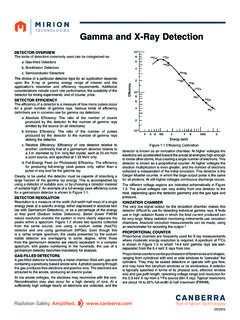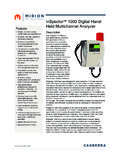Transcription of Spectrum Analysis Introduction - CANBERRA Industries
1 Spectrum Analysis CANBERRA offers a variety of nuclear systems which perform data and has standard deviation s (sigma) equal to N. A graph of PN. Analysis as well as data acquisition. These systems range from for N equal to 3 and to 10 is shown in Figure The curves small stand alone systems to more sophisticated configurations are asymmetric and have the property that N is not exactly the involving a variety of computer platforms. Typical applications most probable value but is close to it. However, as N increases include Environmental Monitoring, Body Burden Analysis , Nuclear the curve becomes more symmetric, and approaches the Gaussian Waste Assay, Safeguards and other applications.
2 Details of these distribution: systems are provided later in this catalog, or in various brochures that are available from CANBERRA . The following section presents 1 2 1 2. some of the typical procedures and calculations involved in nuclear PN = e x / 2N = e x / 2s 2 N 2 . applications. COUNTING STATISTICS Where: x = N N. Radioactive decay occurs randomly in time, so the measurement of The integral of the area under the Gaussian curve is often used to the number of events detected in a given time period is never exact, report errors in terms of a confidence level in percent. For example, but represents an average value with some uncertainty.
3 Better in the value reported as 64 8, 8 is equal to s and represents average values can be obtained by acquiring data over longer time 68% of the area under the appropriate Gaussian curve for N=64. periods. But, since this is not always possible, it is necessary to be It may be stated as the value one is 68% confident of obtaining if able to estimate the accuracy of any given average. the measurement is repeated. Traditionally, many of CANBERRA 's Nuclear events follow a Poisson distribution which is the limiting MCAs have used s, which corresponds to a 90% confidence case of a binomial distribution for an infinite number of time intervals, level.
4 Probable error is often used, which corresponds to a 50%. and closely resembles a Gaussian distribution when the number of confidence level. These can be user-set to other values, such as: observed events is large. The Poisson distribution for observing N. events when the average is N, is given by: Value of % Confidence N 50. N e N PN =. N! 75. 90. 95. Figure Poisson Distributions for N=3 and 10. Radiation Safety. Amplified. Part of Mirion Technologies 10 / 2010. Since the uncertainty depends upon the square root of the counts, However, this is incorrect because the trapezoidal area is not improvements in accuracy by counting longer, or by using a more Poisson distributed and its error is not just the square root of the efficient detector, only increase as the square root.
5 For example, if counts, but depends upon how the errors in B1 and B2 affect the 564 counts are obtained in an hour for 564 24 for a 24/564 horizontal line across the entire region. The proper procedure, = accuracy, counting for two hours to get 1133 counts with which is implemented in CANBERRA MCAs and in Analysis of peak 34 only gives an improvement to In other words, counting areas in various HPGe software packages, is derived as follows: twice as long gives an improvement of 2 = , or 40%. The standard deviation in a function A is given by: Examples of data in which counting statistics apply include: the counts in a counter, the counts in a single channel of an MCA A = f (N1 N2.)
6 Nn). Spectrum , or the sum of counts in a group of channels in an MCA where Nn is the counts in channel N. Spectrum . The situation becomes even more complicated when subtracting a background as shown in the following separate, but frequent, cases. Subtracting background counts, as in one counter's value from another, or for each channel (when subtracting one Spectrum from another). Subtracting a straight line background from a peak on top of the background in a Spectrum , such as a HPGe peak on top of Compton pulses from higher energy gamma rays. The error in adding or subtracting two Poisson distributed numbers with errors, as in: Ntotal = (N1 N1) (N2 N2).
7 Is given by: Ntotal = ( N1)2 + ( N2)2. Consider a low level counting situation in which 56 counts are obtained in 10 minutes, and a background of 38 counts in 10. minutes was measured without the sample. The result is 56 38 = Figure Net Area Determination 18 counts, with an error of 56 + 38 = 94 = or approximately , a value of 54%. The estimate of the standard deviation in A is given by: A better procedure is to measure the background over a longer period of time to obtain a small percentage error and factor to f 2. f 2 1/2. the appropriate time for each sample analyzed. Using the same (A) = 2 (N1) + .. 2 (N2). example as above, but with a 100 minute background of 380 counts, N1 Nn the result would be 56 (380/10) = 18 counts, with an error of 2 2 1/2.
8 N 2 n 2. 56 + ([10/100]2 x 380) = 56 + 38 = = (P1 + .. Pn) + ( B1) + ( B2). 2 2. or approximately , a value of 43%. NET AREA CALCULATION n 2 1/2. For the case in which a peak lies on a background that cannot be = P + (B1 + B2). subtracted by a background Spectrum , such as shown in Figure 2. for an MCA Spectrum from a HPGe detector: Where are the channels in the peak (inside B1 and B2) not The area above the background represents the total counts between including the channels with contents of B1 and B2. the vertical lines minus the trapezoidal area below the horizontal line. If the total counts are P and the end-points of the horizontal line END-POINT AVERAGING.
9 Are B1 and B2, then the net area is given by: If the background is large compared to the peak area, a better determination of background can be made by averaging over n several channels. If B1 is an average over n1 channels, and B2 over A = P (B1 + B2). 2 n2 channels, the area is then: Where: n = The number of channels between B1 and B2. n B1 B2. A = P +. It is tempting to calculate the uncertainty by just using the formula 2 n1 n2. for subtracting two numbers, with standard deviations of: and the standard deviation is: n 2 B1 B2 1/2. N = P + n2 (B1 + B2) (A) = P + 2. + n12 n22. Most CANBERRA MCAs and Analysis software packages perform search capability is provided then a complete sample Analysis end-point averaging with a user-selectable number of end-points.
10 Can be accomplished without operator intervention, which is ideal There are many ways of calculating the net counts under a peak. for analyzing large numbers of samples. All CANBERRA HPGe/. The method described above is a valid, common method, provided computer-based gamma spectroscopy systems provide nuclide that there are no interferences from photopeaks adjacent to the identification through peak searches of spectra and scans of peak of interest, and assuming that the background continuum standard and user-generated nuclide libraries. A sample printout of varies linearly from one side of the peak to the other.










